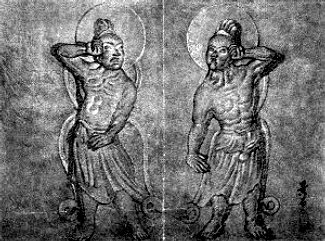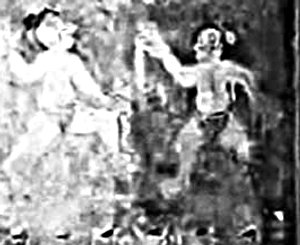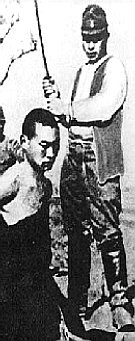2 - A Brief History of Tae Kwon DoTae Kwon Do literally means ""The Way (path) of Kicking and Punching". Do means road, path or way. Kwon means fist, or clench; and Tae is to kick or strike with the foot. At Kyongju in Korea, which was at one time the capital city of the ancient kingdom of Silla, on a temple wall two carvings stand facing each other. Anyone who has studied Tae Kwon Do will be immediately reminded by these carvings of Tae Kwon Do blocking techniques just as they are taught today (you can observe these particular moves in the 2nd dan black belt pattern Keum gang, or "Diamond.") These statues have been reliably dated from the Shil La dynasty, in the sixth century A.D. Here is solid evidence that some foundations of the art we call Tae Kwon Do today were practiced more than one thousand, three hundred years ago in the area now called Korea. There are even earlier hints than this; on the ceilings and walls of the tombs of Koguryo, an even more ancient kingdom in the area now called Korea, we find mural paintings of men performing actions that may be similar to Tae Kwon Do exercises. These murals date from between 3 A.D. and 427 A.D. The roots of Tae Kwon Do may extend much further; it is very difficult to tell. But, it is clear that some aspects of hard style Korean martial arts are quite old - as old, or older, than other martial arts such as those from Japan or Okinawa. China and India also have a history of early development of martial arts, yet the indications described here predate much of that as well. In the early 20th century, Korea was invaded and subsequently occupied by the Japanese. The Japanese forbid the use of the Korean language, and the practice of Korean martial arts. The repression was savage, brutal and efficient. Patriotic Koreans continued to practice their arts in secret, but in public studied the arts brought by the Japanese, which were (and are) in some part derived from the Okinowan fighting systems. It was not until the liberation of Korea in 1945 that Korean martial arts could again be practiced openly. As a result, some Tae Kwon Do kwans (schools or systems) including the one ours was derived from (the Ji Do Kwan), incorporate some fighting skills from the Okinowan systems. This can be seen in the Pyung An forms, which are Okinowan derived, and the Pal Gwe forms, which were developed by Koreans trained in the Japanese styles of Karate. The Tae Geuk forms, introduced by the World Tae Kwon Do Federation in the late 1980's, represesent an attempt to return to form styles more purely rooted in the Korean traditions, and we teach those as well. These patterns are easily distinguished by the linear moves and square angles within. Within the broad scope of Tae Kwon Do, there are many different factions, or schools of thought. Our source school, or "kwan", is known as the Ji Do Kwan, more specifically the Tae Han (Great Korean) Tae Kwon Do Ji Do Kwan. Our branch specifically is the Mi Guk (American) Tae Kwon Do Ji Do Kwan. The Mi Kuk Tae Kwon Do Ji Do Kwan not only incorporates all three of the previously mentioned form styles, but also incorporates techniques from Hap ki do, which in turn was derived from the Japanese Ai ki do style, as well as Ju do grappling skills and Chinese Chin na joint locking techniques. The Mi Kuk Tae Kwon Do Ji Do Kwan therefore teaches a broad and deep martial art, with roots in several different skills and styles. The Mi Kuk Tae Kwon Do Ji Do Kwan is determined to prevent the classic Ji Do Kwan skills from being lost, while still bringing a broader, more general approach to martial arts to our students. The banner above and to the right is read from top to bottom, one character per syllable. The first character is Mi, which means beautiful, and the second character is Kuk, which means country. Together in this order, these characters mean America in many asian languages including Korean, Chinese and Japanese. The next three characters are Tae Kwon Do, or literally and without consideration of proper grammar, "kicking punching way"; and the last three are Ji (wisdom) Do (way) Kwan (school.)
While the characters and their general meaning are the same in many asian traditions, the sounds for the characters in the various languages are usually not. These characters are old, and they have been used for writing throughout asia for many, many centuries. This is why they are common to many modern asian cultures.
Keyboard Navigation
, Previous Page . Next Page t TOC i Index |



